Networking Security Report: Threats, Techniques, and Future Solutions
VerifiedAdded on 2023/06/07
|8
|3208
|244
Report
AI Summary
This report provides a comprehensive overview of network security, delving into the critical aspects of data protection and network integrity. It begins by outlining the fundamental aims of network security, including confidentiality, integrity, and availability, and explains the threats that can compromise these goals. The report categorizes security threats into passive and active attacks, detailing methods such as interception, traffic analysis, masquerade, and service denial. It then examines current techniques used to maintain network security, such as cryptography and firewalls, providing insights into their application and effectiveness. Furthermore, the report discusses the importance of network security policies, password management, and up-to-date systems. Finally, it explores potential future solutions, including the integration of Artificial Intelligence (AI) and Software-Defined Networking (SDN), to enhance network defense capabilities and improve overall security.

1
NETWORKING SECURITY
By:
The Name of the class:
Proferssor:
The Name Of The School:
The City and State where it is located:
The Date:
NETWORKING SECURITY
By:
The Name of the class:
Proferssor:
The Name Of The School:
The City and State where it is located:
The Date:
Paraphrase This Document
Need a fresh take? Get an instant paraphrase of this document with our AI Paraphraser
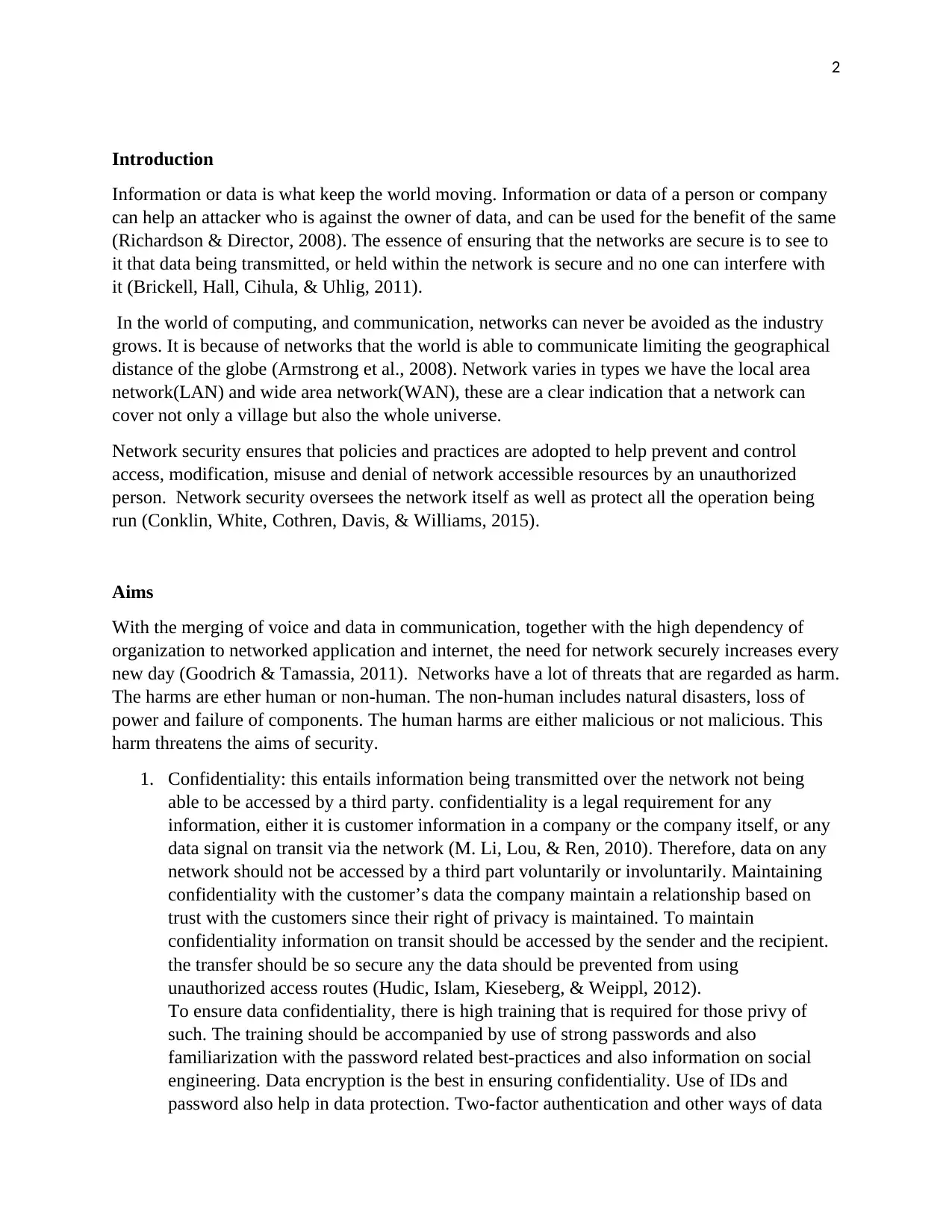
2
Introduction
Information or data is what keep the world moving. Information or data of a person or company
can help an attacker who is against the owner of data, and can be used for the benefit of the same
(Richardson & Director, 2008). The essence of ensuring that the networks are secure is to see to
it that data being transmitted, or held within the network is secure and no one can interfere with
it (Brickell, Hall, Cihula, & Uhlig, 2011).
In the world of computing, and communication, networks can never be avoided as the industry
grows. It is because of networks that the world is able to communicate limiting the geographical
distance of the globe (Armstrong et al., 2008). Network varies in types we have the local area
network(LAN) and wide area network(WAN), these are a clear indication that a network can
cover not only a village but also the whole universe.
Network security ensures that policies and practices are adopted to help prevent and control
access, modification, misuse and denial of network accessible resources by an unauthorized
person. Network security oversees the network itself as well as protect all the operation being
run (Conklin, White, Cothren, Davis, & Williams, 2015).
Aims
With the merging of voice and data in communication, together with the high dependency of
organization to networked application and internet, the need for network securely increases every
new day (Goodrich & Tamassia, 2011). Networks have a lot of threats that are regarded as harm.
The harms are ether human or non-human. The non-human includes natural disasters, loss of
power and failure of components. The human harms are either malicious or not malicious. This
harm threatens the aims of security.
1. Confidentiality: this entails information being transmitted over the network not being
able to be accessed by a third party. confidentiality is a legal requirement for any
information, either it is customer information in a company or the company itself, or any
data signal on transit via the network (M. Li, Lou, & Ren, 2010). Therefore, data on any
network should not be accessed by a third part voluntarily or involuntarily. Maintaining
confidentiality with the customer’s data the company maintain a relationship based on
trust with the customers since their right of privacy is maintained. To maintain
confidentiality information on transit should be accessed by the sender and the recipient.
the transfer should be so secure any the data should be prevented from using
unauthorized access routes (Hudic, Islam, Kieseberg, & Weippl, 2012).
To ensure data confidentiality, there is high training that is required for those privy of
such. The training should be accompanied by use of strong passwords and also
familiarization with the password related best-practices and also information on social
engineering. Data encryption is the best in ensuring confidentiality. Use of IDs and
password also help in data protection. Two-factor authentication and other ways of data
Introduction
Information or data is what keep the world moving. Information or data of a person or company
can help an attacker who is against the owner of data, and can be used for the benefit of the same
(Richardson & Director, 2008). The essence of ensuring that the networks are secure is to see to
it that data being transmitted, or held within the network is secure and no one can interfere with
it (Brickell, Hall, Cihula, & Uhlig, 2011).
In the world of computing, and communication, networks can never be avoided as the industry
grows. It is because of networks that the world is able to communicate limiting the geographical
distance of the globe (Armstrong et al., 2008). Network varies in types we have the local area
network(LAN) and wide area network(WAN), these are a clear indication that a network can
cover not only a village but also the whole universe.
Network security ensures that policies and practices are adopted to help prevent and control
access, modification, misuse and denial of network accessible resources by an unauthorized
person. Network security oversees the network itself as well as protect all the operation being
run (Conklin, White, Cothren, Davis, & Williams, 2015).
Aims
With the merging of voice and data in communication, together with the high dependency of
organization to networked application and internet, the need for network securely increases every
new day (Goodrich & Tamassia, 2011). Networks have a lot of threats that are regarded as harm.
The harms are ether human or non-human. The non-human includes natural disasters, loss of
power and failure of components. The human harms are either malicious or not malicious. This
harm threatens the aims of security.
1. Confidentiality: this entails information being transmitted over the network not being
able to be accessed by a third party. confidentiality is a legal requirement for any
information, either it is customer information in a company or the company itself, or any
data signal on transit via the network (M. Li, Lou, & Ren, 2010). Therefore, data on any
network should not be accessed by a third part voluntarily or involuntarily. Maintaining
confidentiality with the customer’s data the company maintain a relationship based on
trust with the customers since their right of privacy is maintained. To maintain
confidentiality information on transit should be accessed by the sender and the recipient.
the transfer should be so secure any the data should be prevented from using
unauthorized access routes (Hudic, Islam, Kieseberg, & Weippl, 2012).
To ensure data confidentiality, there is high training that is required for those privy of
such. The training should be accompanied by use of strong passwords and also
familiarization with the password related best-practices and also information on social
engineering. Data encryption is the best in ensuring confidentiality. Use of IDs and
password also help in data protection. Two-factor authentication and other ways of data
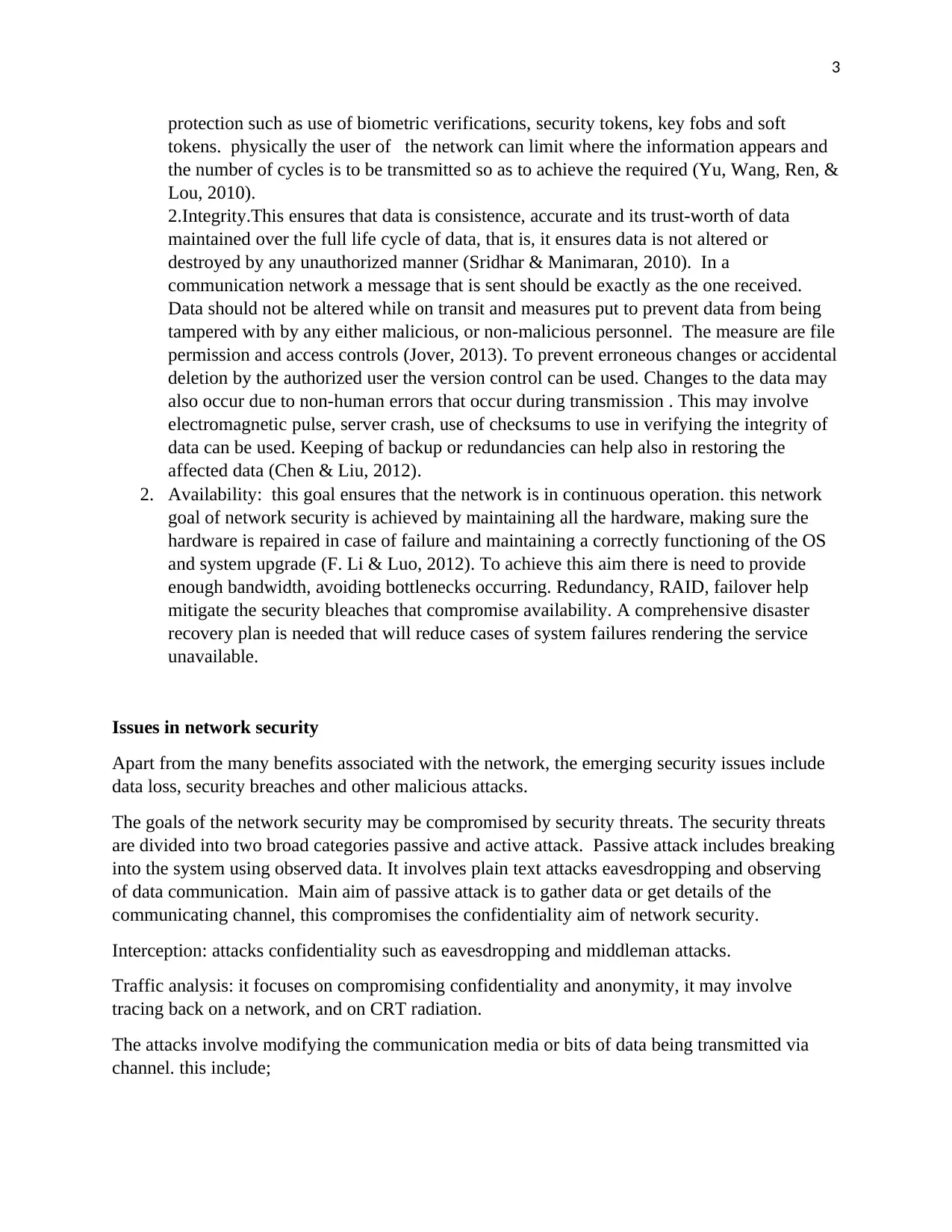
3
protection such as use of biometric verifications, security tokens, key fobs and soft
tokens. physically the user of the network can limit where the information appears and
the number of cycles is to be transmitted so as to achieve the required (Yu, Wang, Ren, &
Lou, 2010).
2.Integrity.This ensures that data is consistence, accurate and its trust-worth of data
maintained over the full life cycle of data, that is, it ensures data is not altered or
destroyed by any unauthorized manner (Sridhar & Manimaran, 2010). In a
communication network a message that is sent should be exactly as the one received.
Data should not be altered while on transit and measures put to prevent data from being
tampered with by any either malicious, or non-malicious personnel. The measure are file
permission and access controls (Jover, 2013). To prevent erroneous changes or accidental
deletion by the authorized user the version control can be used. Changes to the data may
also occur due to non-human errors that occur during transmission . This may involve
electromagnetic pulse, server crash, use of checksums to use in verifying the integrity of
data can be used. Keeping of backup or redundancies can help also in restoring the
affected data (Chen & Liu, 2012).
2. Availability: this goal ensures that the network is in continuous operation. this network
goal of network security is achieved by maintaining all the hardware, making sure the
hardware is repaired in case of failure and maintaining a correctly functioning of the OS
and system upgrade (F. Li & Luo, 2012). To achieve this aim there is need to provide
enough bandwidth, avoiding bottlenecks occurring. Redundancy, RAID, failover help
mitigate the security bleaches that compromise availability. A comprehensive disaster
recovery plan is needed that will reduce cases of system failures rendering the service
unavailable.
Issues in network security
Apart from the many benefits associated with the network, the emerging security issues include
data loss, security breaches and other malicious attacks.
The goals of the network security may be compromised by security threats. The security threats
are divided into two broad categories passive and active attack. Passive attack includes breaking
into the system using observed data. It involves plain text attacks eavesdropping and observing
of data communication. Main aim of passive attack is to gather data or get details of the
communicating channel, this compromises the confidentiality aim of network security.
Interception: attacks confidentiality such as eavesdropping and middleman attacks.
Traffic analysis: it focuses on compromising confidentiality and anonymity, it may involve
tracing back on a network, and on CRT radiation.
The attacks involve modifying the communication media or bits of data being transmitted via
channel. this include;
protection such as use of biometric verifications, security tokens, key fobs and soft
tokens. physically the user of the network can limit where the information appears and
the number of cycles is to be transmitted so as to achieve the required (Yu, Wang, Ren, &
Lou, 2010).
2.Integrity.This ensures that data is consistence, accurate and its trust-worth of data
maintained over the full life cycle of data, that is, it ensures data is not altered or
destroyed by any unauthorized manner (Sridhar & Manimaran, 2010). In a
communication network a message that is sent should be exactly as the one received.
Data should not be altered while on transit and measures put to prevent data from being
tampered with by any either malicious, or non-malicious personnel. The measure are file
permission and access controls (Jover, 2013). To prevent erroneous changes or accidental
deletion by the authorized user the version control can be used. Changes to the data may
also occur due to non-human errors that occur during transmission . This may involve
electromagnetic pulse, server crash, use of checksums to use in verifying the integrity of
data can be used. Keeping of backup or redundancies can help also in restoring the
affected data (Chen & Liu, 2012).
2. Availability: this goal ensures that the network is in continuous operation. this network
goal of network security is achieved by maintaining all the hardware, making sure the
hardware is repaired in case of failure and maintaining a correctly functioning of the OS
and system upgrade (F. Li & Luo, 2012). To achieve this aim there is need to provide
enough bandwidth, avoiding bottlenecks occurring. Redundancy, RAID, failover help
mitigate the security bleaches that compromise availability. A comprehensive disaster
recovery plan is needed that will reduce cases of system failures rendering the service
unavailable.
Issues in network security
Apart from the many benefits associated with the network, the emerging security issues include
data loss, security breaches and other malicious attacks.
The goals of the network security may be compromised by security threats. The security threats
are divided into two broad categories passive and active attack. Passive attack includes breaking
into the system using observed data. It involves plain text attacks eavesdropping and observing
of data communication. Main aim of passive attack is to gather data or get details of the
communicating channel, this compromises the confidentiality aim of network security.
Interception: attacks confidentiality such as eavesdropping and middleman attacks.
Traffic analysis: it focuses on compromising confidentiality and anonymity, it may involve
tracing back on a network, and on CRT radiation.
The attacks involve modifying the communication media or bits of data being transmitted via
channel. this include;
⊘ This is a preview!⊘
Do you want full access?
Subscribe today to unlock all pages.

Trusted by 1+ million students worldwide
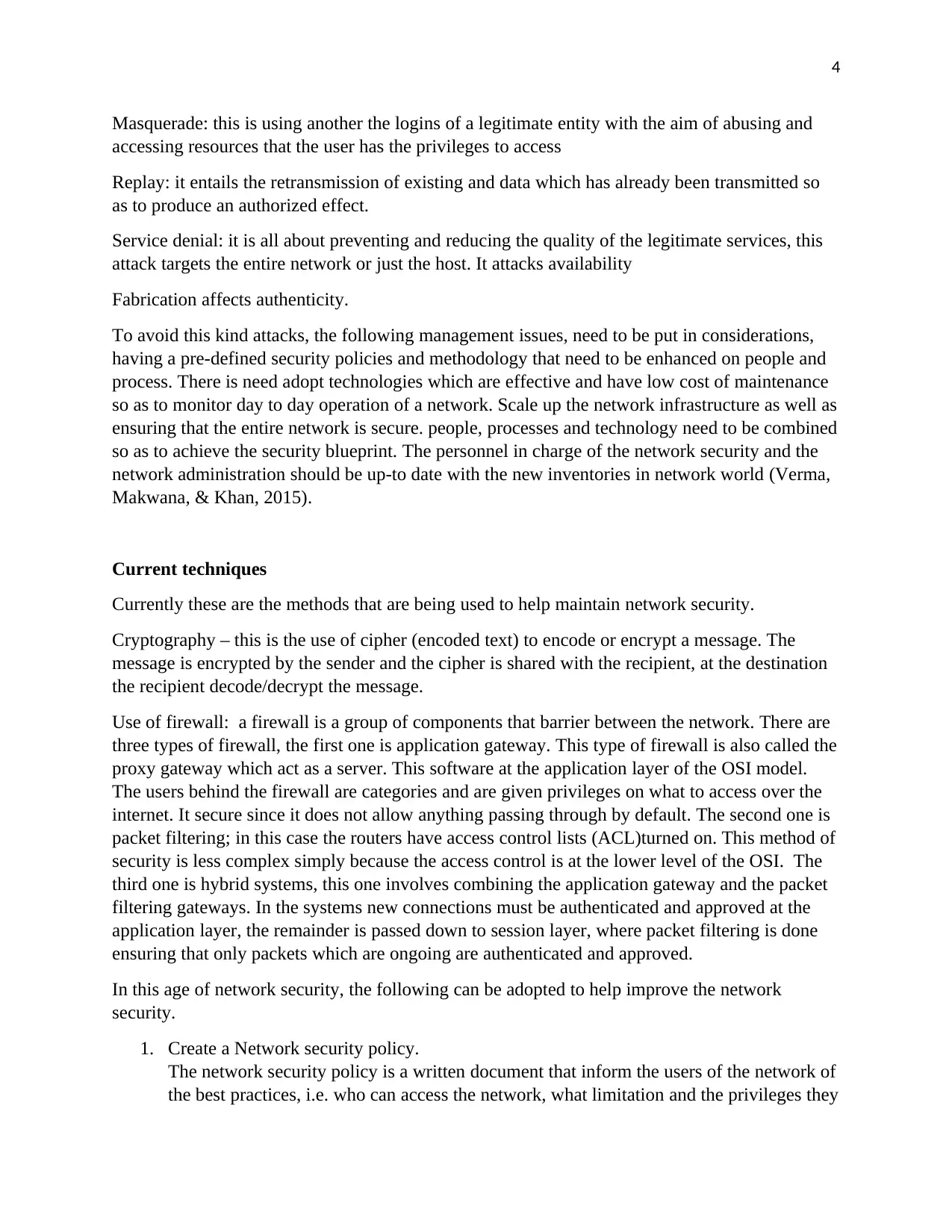
4
Masquerade: this is using another the logins of a legitimate entity with the aim of abusing and
accessing resources that the user has the privileges to access
Replay: it entails the retransmission of existing and data which has already been transmitted so
as to produce an authorized effect.
Service denial: it is all about preventing and reducing the quality of the legitimate services, this
attack targets the entire network or just the host. It attacks availability
Fabrication affects authenticity.
To avoid this kind attacks, the following management issues, need to be put in considerations,
having a pre-defined security policies and methodology that need to be enhanced on people and
process. There is need adopt technologies which are effective and have low cost of maintenance
so as to monitor day to day operation of a network. Scale up the network infrastructure as well as
ensuring that the entire network is secure. people, processes and technology need to be combined
so as to achieve the security blueprint. The personnel in charge of the network security and the
network administration should be up-to date with the new inventories in network world (Verma,
Makwana, & Khan, 2015).
Current techniques
Currently these are the methods that are being used to help maintain network security.
Cryptography – this is the use of cipher (encoded text) to encode or encrypt a message. The
message is encrypted by the sender and the cipher is shared with the recipient, at the destination
the recipient decode/decrypt the message.
Use of firewall: a firewall is a group of components that barrier between the network. There are
three types of firewall, the first one is application gateway. This type of firewall is also called the
proxy gateway which act as a server. This software at the application layer of the OSI model.
The users behind the firewall are categories and are given privileges on what to access over the
internet. It secure since it does not allow anything passing through by default. The second one is
packet filtering; in this case the routers have access control lists (ACL)turned on. This method of
security is less complex simply because the access control is at the lower level of the OSI. The
third one is hybrid systems, this one involves combining the application gateway and the packet
filtering gateways. In the systems new connections must be authenticated and approved at the
application layer, the remainder is passed down to session layer, where packet filtering is done
ensuring that only packets which are ongoing are authenticated and approved.
In this age of network security, the following can be adopted to help improve the network
security.
1. Create a Network security policy.
The network security policy is a written document that inform the users of the network of
the best practices, i.e. who can access the network, what limitation and the privileges they
Masquerade: this is using another the logins of a legitimate entity with the aim of abusing and
accessing resources that the user has the privileges to access
Replay: it entails the retransmission of existing and data which has already been transmitted so
as to produce an authorized effect.
Service denial: it is all about preventing and reducing the quality of the legitimate services, this
attack targets the entire network or just the host. It attacks availability
Fabrication affects authenticity.
To avoid this kind attacks, the following management issues, need to be put in considerations,
having a pre-defined security policies and methodology that need to be enhanced on people and
process. There is need adopt technologies which are effective and have low cost of maintenance
so as to monitor day to day operation of a network. Scale up the network infrastructure as well as
ensuring that the entire network is secure. people, processes and technology need to be combined
so as to achieve the security blueprint. The personnel in charge of the network security and the
network administration should be up-to date with the new inventories in network world (Verma,
Makwana, & Khan, 2015).
Current techniques
Currently these are the methods that are being used to help maintain network security.
Cryptography – this is the use of cipher (encoded text) to encode or encrypt a message. The
message is encrypted by the sender and the cipher is shared with the recipient, at the destination
the recipient decode/decrypt the message.
Use of firewall: a firewall is a group of components that barrier between the network. There are
three types of firewall, the first one is application gateway. This type of firewall is also called the
proxy gateway which act as a server. This software at the application layer of the OSI model.
The users behind the firewall are categories and are given privileges on what to access over the
internet. It secure since it does not allow anything passing through by default. The second one is
packet filtering; in this case the routers have access control lists (ACL)turned on. This method of
security is less complex simply because the access control is at the lower level of the OSI. The
third one is hybrid systems, this one involves combining the application gateway and the packet
filtering gateways. In the systems new connections must be authenticated and approved at the
application layer, the remainder is passed down to session layer, where packet filtering is done
ensuring that only packets which are ongoing are authenticated and approved.
In this age of network security, the following can be adopted to help improve the network
security.
1. Create a Network security policy.
The network security policy is a written document that inform the users of the network of
the best practices, i.e. who can access the network, what limitation and the privileges they
Paraphrase This Document
Need a fresh take? Get an instant paraphrase of this document with our AI Paraphraser
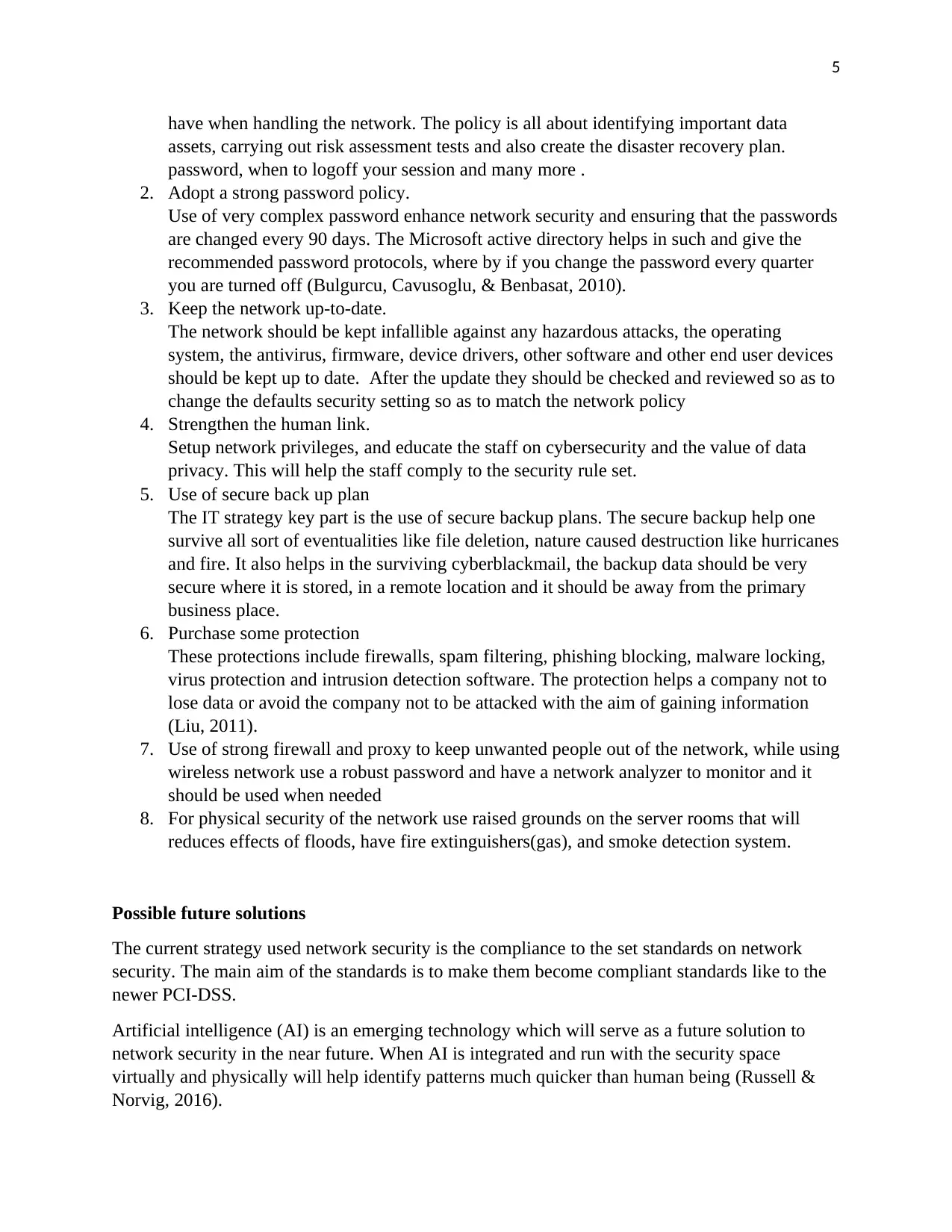
5
have when handling the network. The policy is all about identifying important data
assets, carrying out risk assessment tests and also create the disaster recovery plan.
password, when to logoff your session and many more .
2. Adopt a strong password policy.
Use of very complex password enhance network security and ensuring that the passwords
are changed every 90 days. The Microsoft active directory helps in such and give the
recommended password protocols, where by if you change the password every quarter
you are turned off (Bulgurcu, Cavusoglu, & Benbasat, 2010).
3. Keep the network up-to-date.
The network should be kept infallible against any hazardous attacks, the operating
system, the antivirus, firmware, device drivers, other software and other end user devices
should be kept up to date. After the update they should be checked and reviewed so as to
change the defaults security setting so as to match the network policy
4. Strengthen the human link.
Setup network privileges, and educate the staff on cybersecurity and the value of data
privacy. This will help the staff comply to the security rule set.
5. Use of secure back up plan
The IT strategy key part is the use of secure backup plans. The secure backup help one
survive all sort of eventualities like file deletion, nature caused destruction like hurricanes
and fire. It also helps in the surviving cyberblackmail, the backup data should be very
secure where it is stored, in a remote location and it should be away from the primary
business place.
6. Purchase some protection
These protections include firewalls, spam filtering, phishing blocking, malware locking,
virus protection and intrusion detection software. The protection helps a company not to
lose data or avoid the company not to be attacked with the aim of gaining information
(Liu, 2011).
7. Use of strong firewall and proxy to keep unwanted people out of the network, while using
wireless network use a robust password and have a network analyzer to monitor and it
should be used when needed
8. For physical security of the network use raised grounds on the server rooms that will
reduces effects of floods, have fire extinguishers(gas), and smoke detection system.
Possible future solutions
The current strategy used network security is the compliance to the set standards on network
security. The main aim of the standards is to make them become compliant standards like to the
newer PCI-DSS.
Artificial intelligence (AI) is an emerging technology which will serve as a future solution to
network security in the near future. When AI is integrated and run with the security space
virtually and physically will help identify patterns much quicker than human being (Russell &
Norvig, 2016).
have when handling the network. The policy is all about identifying important data
assets, carrying out risk assessment tests and also create the disaster recovery plan.
password, when to logoff your session and many more .
2. Adopt a strong password policy.
Use of very complex password enhance network security and ensuring that the passwords
are changed every 90 days. The Microsoft active directory helps in such and give the
recommended password protocols, where by if you change the password every quarter
you are turned off (Bulgurcu, Cavusoglu, & Benbasat, 2010).
3. Keep the network up-to-date.
The network should be kept infallible against any hazardous attacks, the operating
system, the antivirus, firmware, device drivers, other software and other end user devices
should be kept up to date. After the update they should be checked and reviewed so as to
change the defaults security setting so as to match the network policy
4. Strengthen the human link.
Setup network privileges, and educate the staff on cybersecurity and the value of data
privacy. This will help the staff comply to the security rule set.
5. Use of secure back up plan
The IT strategy key part is the use of secure backup plans. The secure backup help one
survive all sort of eventualities like file deletion, nature caused destruction like hurricanes
and fire. It also helps in the surviving cyberblackmail, the backup data should be very
secure where it is stored, in a remote location and it should be away from the primary
business place.
6. Purchase some protection
These protections include firewalls, spam filtering, phishing blocking, malware locking,
virus protection and intrusion detection software. The protection helps a company not to
lose data or avoid the company not to be attacked with the aim of gaining information
(Liu, 2011).
7. Use of strong firewall and proxy to keep unwanted people out of the network, while using
wireless network use a robust password and have a network analyzer to monitor and it
should be used when needed
8. For physical security of the network use raised grounds on the server rooms that will
reduces effects of floods, have fire extinguishers(gas), and smoke detection system.
Possible future solutions
The current strategy used network security is the compliance to the set standards on network
security. The main aim of the standards is to make them become compliant standards like to the
newer PCI-DSS.
Artificial intelligence (AI) is an emerging technology which will serve as a future solution to
network security in the near future. When AI is integrated and run with the security space
virtually and physically will help identify patterns much quicker than human being (Russell &
Norvig, 2016).
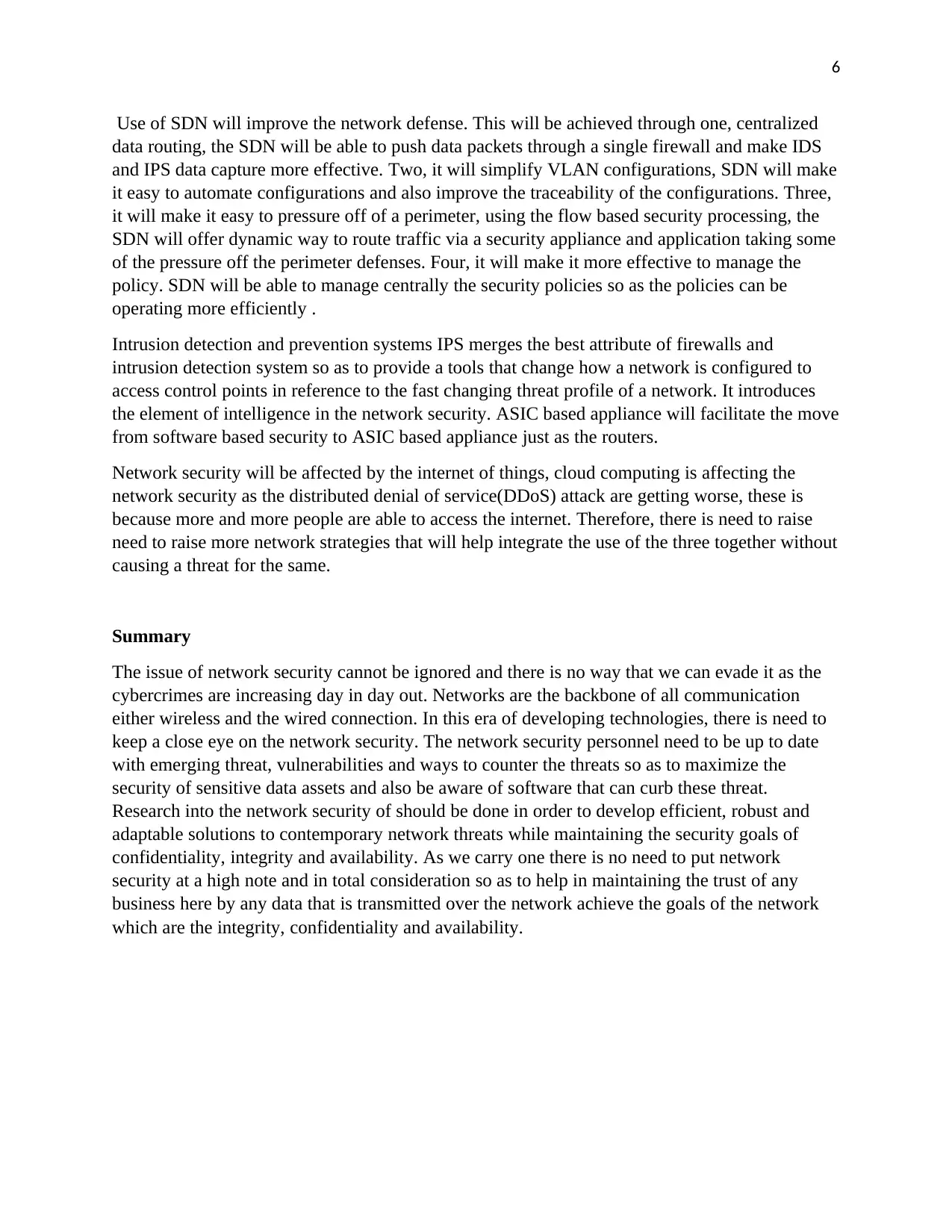
6
Use of SDN will improve the network defense. This will be achieved through one, centralized
data routing, the SDN will be able to push data packets through a single firewall and make IDS
and IPS data capture more effective. Two, it will simplify VLAN configurations, SDN will make
it easy to automate configurations and also improve the traceability of the configurations. Three,
it will make it easy to pressure off of a perimeter, using the flow based security processing, the
SDN will offer dynamic way to route traffic via a security appliance and application taking some
of the pressure off the perimeter defenses. Four, it will make it more effective to manage the
policy. SDN will be able to manage centrally the security policies so as the policies can be
operating more efficiently .
Intrusion detection and prevention systems IPS merges the best attribute of firewalls and
intrusion detection system so as to provide a tools that change how a network is configured to
access control points in reference to the fast changing threat profile of a network. It introduces
the element of intelligence in the network security. ASIC based appliance will facilitate the move
from software based security to ASIC based appliance just as the routers.
Network security will be affected by the internet of things, cloud computing is affecting the
network security as the distributed denial of service(DDoS) attack are getting worse, these is
because more and more people are able to access the internet. Therefore, there is need to raise
need to raise more network strategies that will help integrate the use of the three together without
causing a threat for the same.
Summary
The issue of network security cannot be ignored and there is no way that we can evade it as the
cybercrimes are increasing day in day out. Networks are the backbone of all communication
either wireless and the wired connection. In this era of developing technologies, there is need to
keep a close eye on the network security. The network security personnel need to be up to date
with emerging threat, vulnerabilities and ways to counter the threats so as to maximize the
security of sensitive data assets and also be aware of software that can curb these threat.
Research into the network security of should be done in order to develop efficient, robust and
adaptable solutions to contemporary network threats while maintaining the security goals of
confidentiality, integrity and availability. As we carry one there is no need to put network
security at a high note and in total consideration so as to help in maintaining the trust of any
business here by any data that is transmitted over the network achieve the goals of the network
which are the integrity, confidentiality and availability.
Use of SDN will improve the network defense. This will be achieved through one, centralized
data routing, the SDN will be able to push data packets through a single firewall and make IDS
and IPS data capture more effective. Two, it will simplify VLAN configurations, SDN will make
it easy to automate configurations and also improve the traceability of the configurations. Three,
it will make it easy to pressure off of a perimeter, using the flow based security processing, the
SDN will offer dynamic way to route traffic via a security appliance and application taking some
of the pressure off the perimeter defenses. Four, it will make it more effective to manage the
policy. SDN will be able to manage centrally the security policies so as the policies can be
operating more efficiently .
Intrusion detection and prevention systems IPS merges the best attribute of firewalls and
intrusion detection system so as to provide a tools that change how a network is configured to
access control points in reference to the fast changing threat profile of a network. It introduces
the element of intelligence in the network security. ASIC based appliance will facilitate the move
from software based security to ASIC based appliance just as the routers.
Network security will be affected by the internet of things, cloud computing is affecting the
network security as the distributed denial of service(DDoS) attack are getting worse, these is
because more and more people are able to access the internet. Therefore, there is need to raise
need to raise more network strategies that will help integrate the use of the three together without
causing a threat for the same.
Summary
The issue of network security cannot be ignored and there is no way that we can evade it as the
cybercrimes are increasing day in day out. Networks are the backbone of all communication
either wireless and the wired connection. In this era of developing technologies, there is need to
keep a close eye on the network security. The network security personnel need to be up to date
with emerging threat, vulnerabilities and ways to counter the threats so as to maximize the
security of sensitive data assets and also be aware of software that can curb these threat.
Research into the network security of should be done in order to develop efficient, robust and
adaptable solutions to contemporary network threats while maintaining the security goals of
confidentiality, integrity and availability. As we carry one there is no need to put network
security at a high note and in total consideration so as to help in maintaining the trust of any
business here by any data that is transmitted over the network achieve the goals of the network
which are the integrity, confidentiality and availability.
⊘ This is a preview!⊘
Do you want full access?
Subscribe today to unlock all pages.

Trusted by 1+ million students worldwide
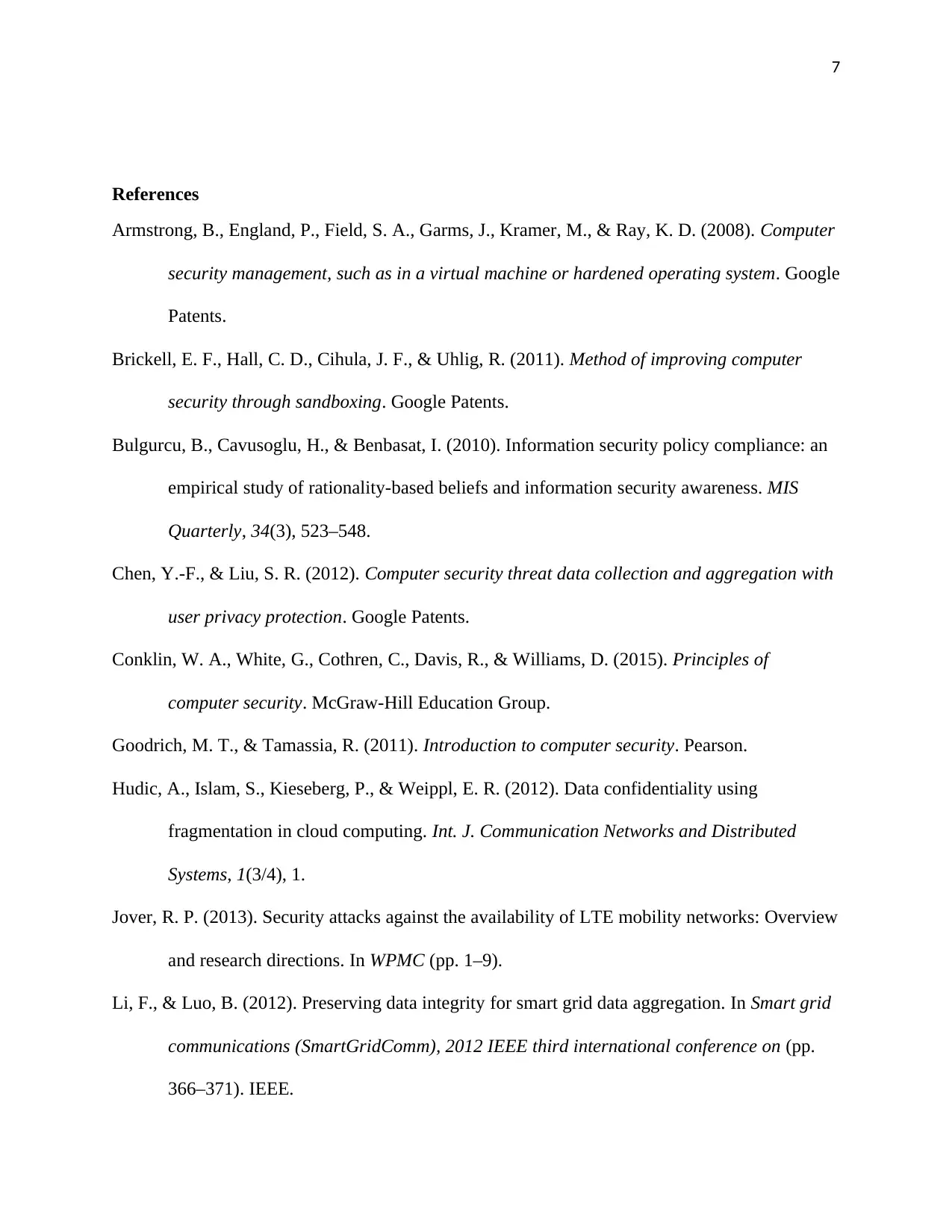
7
References
Armstrong, B., England, P., Field, S. A., Garms, J., Kramer, M., & Ray, K. D. (2008). Computer
security management, such as in a virtual machine or hardened operating system. Google
Patents.
Brickell, E. F., Hall, C. D., Cihula, J. F., & Uhlig, R. (2011). Method of improving computer
security through sandboxing. Google Patents.
Bulgurcu, B., Cavusoglu, H., & Benbasat, I. (2010). Information security policy compliance: an
empirical study of rationality-based beliefs and information security awareness. MIS
Quarterly, 34(3), 523–548.
Chen, Y.-F., & Liu, S. R. (2012). Computer security threat data collection and aggregation with
user privacy protection. Google Patents.
Conklin, W. A., White, G., Cothren, C., Davis, R., & Williams, D. (2015). Principles of
computer security. McGraw-Hill Education Group.
Goodrich, M. T., & Tamassia, R. (2011). Introduction to computer security. Pearson.
Hudic, A., Islam, S., Kieseberg, P., & Weippl, E. R. (2012). Data confidentiality using
fragmentation in cloud computing. Int. J. Communication Networks and Distributed
Systems, 1(3/4), 1.
Jover, R. P. (2013). Security attacks against the availability of LTE mobility networks: Overview
and research directions. In WPMC (pp. 1–9).
Li, F., & Luo, B. (2012). Preserving data integrity for smart grid data aggregation. In Smart grid
communications (SmartGridComm), 2012 IEEE third international conference on (pp.
366–371). IEEE.
References
Armstrong, B., England, P., Field, S. A., Garms, J., Kramer, M., & Ray, K. D. (2008). Computer
security management, such as in a virtual machine or hardened operating system. Google
Patents.
Brickell, E. F., Hall, C. D., Cihula, J. F., & Uhlig, R. (2011). Method of improving computer
security through sandboxing. Google Patents.
Bulgurcu, B., Cavusoglu, H., & Benbasat, I. (2010). Information security policy compliance: an
empirical study of rationality-based beliefs and information security awareness. MIS
Quarterly, 34(3), 523–548.
Chen, Y.-F., & Liu, S. R. (2012). Computer security threat data collection and aggregation with
user privacy protection. Google Patents.
Conklin, W. A., White, G., Cothren, C., Davis, R., & Williams, D. (2015). Principles of
computer security. McGraw-Hill Education Group.
Goodrich, M. T., & Tamassia, R. (2011). Introduction to computer security. Pearson.
Hudic, A., Islam, S., Kieseberg, P., & Weippl, E. R. (2012). Data confidentiality using
fragmentation in cloud computing. Int. J. Communication Networks and Distributed
Systems, 1(3/4), 1.
Jover, R. P. (2013). Security attacks against the availability of LTE mobility networks: Overview
and research directions. In WPMC (pp. 1–9).
Li, F., & Luo, B. (2012). Preserving data integrity for smart grid data aggregation. In Smart grid
communications (SmartGridComm), 2012 IEEE third international conference on (pp.
366–371). IEEE.
Paraphrase This Document
Need a fresh take? Get an instant paraphrase of this document with our AI Paraphraser
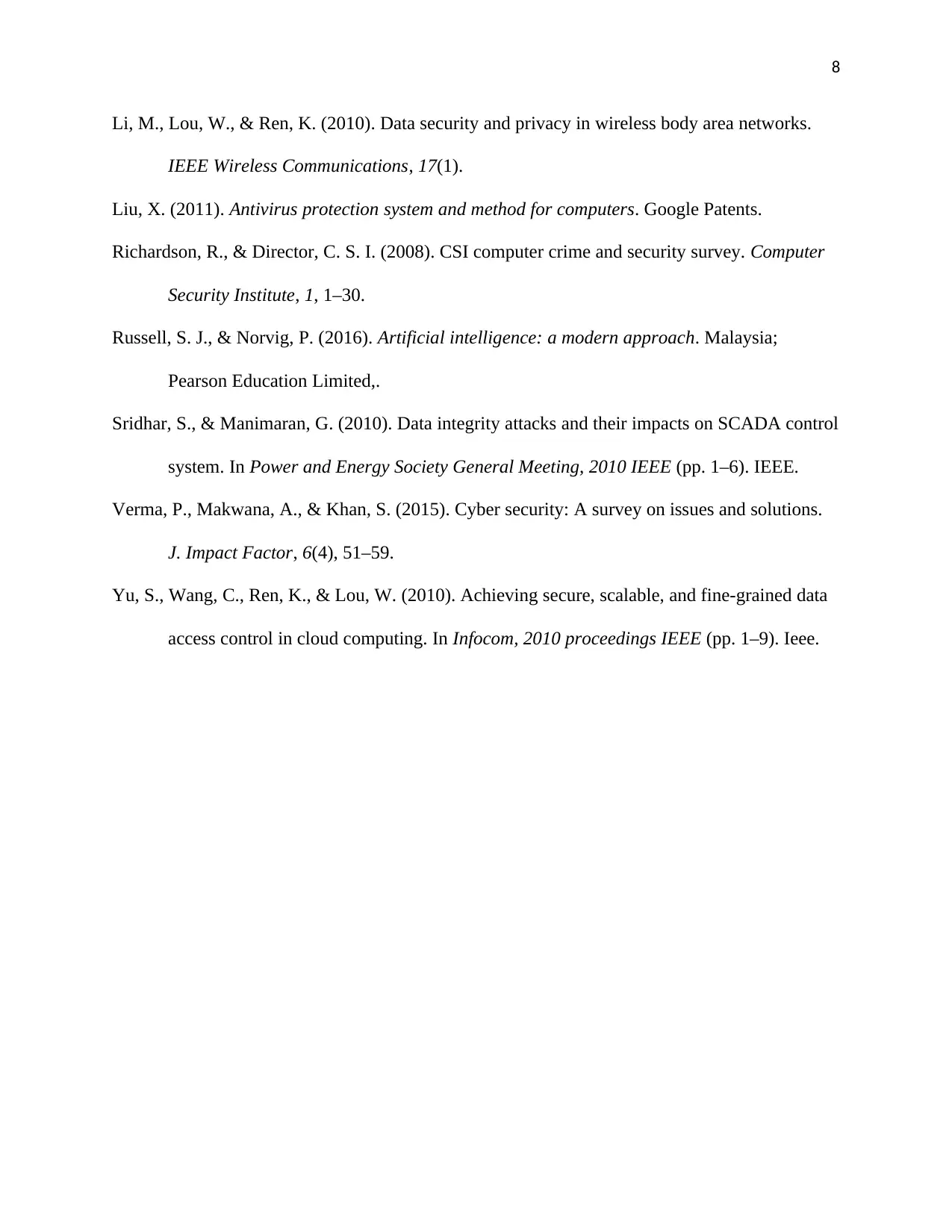
8
Li, M., Lou, W., & Ren, K. (2010). Data security and privacy in wireless body area networks.
IEEE Wireless Communications, 17(1).
Liu, X. (2011). Antivirus protection system and method for computers. Google Patents.
Richardson, R., & Director, C. S. I. (2008). CSI computer crime and security survey. Computer
Security Institute, 1, 1–30.
Russell, S. J., & Norvig, P. (2016). Artificial intelligence: a modern approach. Malaysia;
Pearson Education Limited,.
Sridhar, S., & Manimaran, G. (2010). Data integrity attacks and their impacts on SCADA control
system. In Power and Energy Society General Meeting, 2010 IEEE (pp. 1–6). IEEE.
Verma, P., Makwana, A., & Khan, S. (2015). Cyber security: A survey on issues and solutions.
J. Impact Factor, 6(4), 51–59.
Yu, S., Wang, C., Ren, K., & Lou, W. (2010). Achieving secure, scalable, and fine-grained data
access control in cloud computing. In Infocom, 2010 proceedings IEEE (pp. 1–9). Ieee.
Li, M., Lou, W., & Ren, K. (2010). Data security and privacy in wireless body area networks.
IEEE Wireless Communications, 17(1).
Liu, X. (2011). Antivirus protection system and method for computers. Google Patents.
Richardson, R., & Director, C. S. I. (2008). CSI computer crime and security survey. Computer
Security Institute, 1, 1–30.
Russell, S. J., & Norvig, P. (2016). Artificial intelligence: a modern approach. Malaysia;
Pearson Education Limited,.
Sridhar, S., & Manimaran, G. (2010). Data integrity attacks and their impacts on SCADA control
system. In Power and Energy Society General Meeting, 2010 IEEE (pp. 1–6). IEEE.
Verma, P., Makwana, A., & Khan, S. (2015). Cyber security: A survey on issues and solutions.
J. Impact Factor, 6(4), 51–59.
Yu, S., Wang, C., Ren, K., & Lou, W. (2010). Achieving secure, scalable, and fine-grained data
access control in cloud computing. In Infocom, 2010 proceedings IEEE (pp. 1–9). Ieee.
1 out of 8
Related Documents
Your All-in-One AI-Powered Toolkit for Academic Success.
+13062052269
info@desklib.com
Available 24*7 on WhatsApp / Email
![[object Object]](/_next/static/media/star-bottom.7253800d.svg)
Unlock your academic potential
Copyright © 2020–2025 A2Z Services. All Rights Reserved. Developed and managed by ZUCOL.




